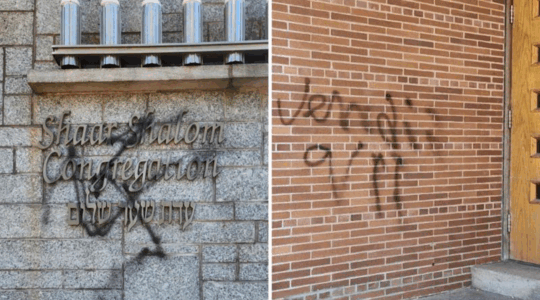COLUMN
ROME (JTA) — One year ago I joined my father, my brothers and their families, as well as a few other friends and relatives, at my mother’s grave in Santa Monica, Calif.
It was close to the first anniversary of Mom’s death, and we gathered with a rabbi for a ceremony to unveil her headstone.
Mom is buried in a municipal cemetery shaded by palm trees. Like most of the other grave markers there, a simple, flat plaque rather than a standing tombstone denotes her resting place.
All that is written about her is her name and the years of her birth and death. And there’s a menorah, following the tradition of marking Jewish women’s graves with depictions of candlesticks.
But there is no epitaph. Nothing that tells about who she was, where she came from, how she lived or the way she was regarded.
The fifth commandment enjoins us to honor our fathers and mothers.
This year, as the second anniversary of Mom’s death approached, my brothers and I joined the growing ranks of children who now choose to honor their parents online, creating a Web site to celebrate our mother’s life and commemorate her. Also, since my mother was an artist, we wanted to share images and information about her work.
Essentially what we did with the Web site was to etch an epitaph for Mom in cyberspace, picking up on an age-old tradition of personifying the deceased through words chiseled into solid stone.
My brothers and I all collected material and supplied content, but I was the one who designed the site, sticking to several basic priorities.
For one, the software had to be easy to use. We had to be able to post both text and photos. Since we wanted to encourage response and interaction, we also needed a format that combined a Web site with a blog.
The Web sites built by friends of mine for their parents run the gamut from simple memorials aimed primarily at family and close friends to elaborate multimedia constructions or sites aimed at placing a personal life story into the context of broader history.
The Web site for Lore Rasmussen, who died in January, details her life as a Jewish refugee from Nazi Germany who went on to become an American civil rights activist and educator. The site that artist Josh Gosfield put up to honor his father, Gene, includes animation and a jivey rap poem.
“In the two minutes that it takes from beginning to end, I recall his life — that which I know only through stories, that which I experienced firsthand, and that which I imagined,” Josh told me.
I considered various formats, but in the end I chose a simple wordpress.com blog template. It’s not overly ambitious, but it’s straightforward — as was my mother — and so far it seems to fit the bill.
People already have begun to find it.
“I was so happy to come across this website. Your parents were very important to me when I was a young child,” reads our first post, a moving tribute from a woman who knew my folks 25 years ago.
“I am so glad that you started this website,” she added, “if only for the opportunity that it gave me to reflect on what your mother and father meant to me.”
In my work over the past two decades, I’ve visited hundreds of Jewish cemeteries where lives and life stories endure in sculpted form, sometimes for centuries.
Some epitaphs use stock phrases and pious platitudes. But some tombstones bear elaborate carvings, with symbols denoting the name, heritage, attributes or profession of the deceased. Others feature epitaphs that read like full-blown CVs — birth place, death place, education, professional positions, honors, titles, family.
Sometimes I get a chill when I read these persisting evocations of rich and complex lives.
Because of the Holocaust, most of the the people buried in Jewish cemeteries in Central Europe have left no direct descendants. The cemeteries themselves often are overgrown and abandoned. Still, here are the declarations of love and bereavement, of honor and respect.
For example, I never knew my great-grandmother, Ettel Gruber. She was the mother of my father’s father, and I was given my middle name in her honor. Ettel died in Romania, well up in her 90s, in 1947, having survived the Holocaust.
Prewar pictures show her with a stern-looking visage. But her epitaph calls her “a positive and dedicated woman, fair and kind in all her doing; (she) offered hospitality and charity to the poor and set a full table for the Tzaddikim.”
Cyberspace is not stone, and I have no idea how long the online epitaphs we are creating with our Web sites will endure.
I do know, however, that if you Google my mother’s name, you’ll find her. And if you follow the link, you’ll get to know something about who she was and why we still care so much about her.
The Web site for my mother, Shirley Moskowitz Gruber, is at shirleymoskowitz.wordpress.com.
(Ruth Ellen Gruber’s books include “National Geographic Jewish Heritage Travel: A Guide to Eastern Europe,” “Letters from Europe (and Elsewhere),” and “Virtually Jewish: Reinventing Jewish Culture in Europe.” She blogs on Jewish heritage issues at jewish-heritage-travel.blogspot.com.)
JTA has documented Jewish history in real-time for over a century. Keep our journalism strong by joining us in supporting independent, award-winning reporting.





